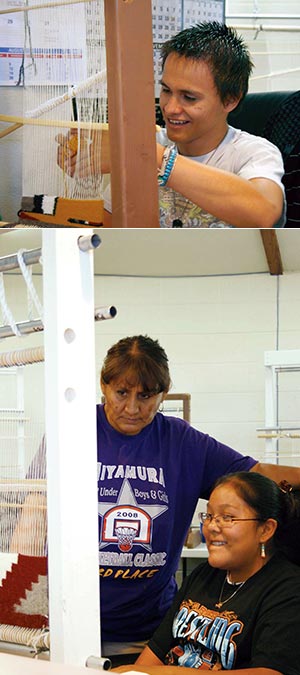Teaching thick fingers to weave
Bááháálí summer program pays students to learn cultural skills
By Jason Begay
Navajo Times
BÁÁHÁÁLÍ, N.M., July 23, 2009

(Times Photo - Stacy Thacker)
TOP PHOTO: Stephen Garcia, 16, gets artistic with his rug as he adds abstract designs during a weaving project July 9 in Bread Springs, N.M.
BOTTOM PHOTO: Allissa Copi smiles as she gets approval of her rug from supervisor Elouise Washburn. (Times Photo - Stacy Thacker)
The hard part — stringing the thin, white thread through the loom to create a meticulous, geometric field — was behind him, now it was mostly concentration and color coordination as the weaver wraps the yarn through the loom with surgeon-like precision.
"Ahhhh," he says in hushed frustration. "I already went this way with the yellow."
Well, maybe not a surgeon. But he's getting there.
This is Stephen Garcia's first rug, an impressive design of a dead tree in dark colors set against a warm yellow background. He is still in the beginning stages, about four inches high on the 18-inch wide rug.
His mistake was to guide the yellow yarn through the vertical warp threads the same way twice, instead of in alternating paths.
"It's getting easier," Garcia said.
That could be the mantra for all of the 14 students enrolled in the summer weaving program at the Bááháálí (formerly Bread Springs) Chapter, a three-year-old project designed to boost the traditional art form among the community's youth.
"We are trying to put that seed in our youth," said Gloria M. Skeet deCruz, chapter manager. "Hopefully, at least one of them will end up really taking an interest in weaving."
deCruz started the weaving program in 2007, after she realized that the chapter had only one person apply for its summer employment weaving program. That program is geared for adults and pays artisans to weave a rug or sew a quilt in the chapter house.
In 2006, deCruz realized that the chapter offered 10 positions, ideally five to weave and five to sew. Of the 20 applications, 19 had applied to sew, and only one had applied for the weaving portion.
"I was kind of shocked about that," deCruz said. "I remember how a lot of women weaved around the Bááháálí area."
The following summer, the chapter - which was certified under the Local Governance Act by the Navajo Nation last Christmas - launched its summer weaving project with six young ladies participating.
"We had even lost one (weaver) that same year," deCruz said.
Although several weavers are still around, most have given up the art as they age.
"Maybe they stopped because of their job," said Elouise Washburn, the weaving project supervisor, a lifelong weaver who now teaches the students. "Some are old, they have arthritis, they say they can't sit down for a long time."
Washburn learned how to weave from her mother, who can no longer see well enough to weave herself.
"So I'm glad to see these guys and young ladies take in interest," Washburn said. "We can give them some kind of idea what rug weaving is."
The program has grown and now welcomes 14 students for a four-week program that includes several other aspects of traditional life.
The students sat in on a session on wool felting, pressing stacks of wool into a fine fabric. On Monday, the students helped butcher a sheep and prepare a feast. The group is expected to visit the Navajo Nation museum on Friday.
The students started July 6 by stringing their own looms, possibly the hardest part of weaving. The warp strings must be laced around the top and bottom rods of the loom in an exact method. The strings must come down the loom in evenly spaced parallel lines.
Garcia, 16, strung his loom incorrectly. He forgot two loops along the top rod. As a result, when he lifted the grid, two of the warp strings in the middle of the field dropped limply.
"I had to do the whole thing over again," Garcia said.
Technically, the weaving project is a summer youth employment program. So the students get paid to attend the courses, four days a week, up to 32 hours. The students are paid minimum wage. They also must pay a $30 fee for the course supplies.
Garcia a senior at Gallup Catholic High School sat next to Lance Pinto, 17, a senior at Gallup High School. They are the first and only young men to participate in the program.
"I wanted to try the art of weaving," Garcia said simply of his wishes to enroll in the program. "I want to try out a lot of things in my life."
Pinto chimed in, half-jokingly adding: "Yeah, learning is great."
If Garcia's design of a dead tree is complicated, Pinto's design of a portrait of President Joe Shirley Jr. is nothing short of a marvel.
His rug was still in the beginning stages, a black strip with a white "V' cut into the middle. That "V" would be Shirley's shirt under his suit jacket. Pinto took his design from a portrait that is hanging in the chapter house.
"I don't know, I just chose it. He's an idol," Pinto said, again, half-joking. "When I'm done, they'll switch mine, take that picture down and put up this rug."
Unlike Garcia, who wants to major in the arts, Pinto has no artistic streak. He'd rather work on mechanics, preferably trucks.
"This is hard," Pinto said. "It's harder than working on a truck."

